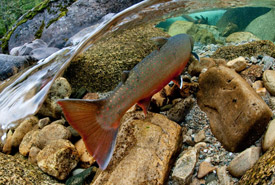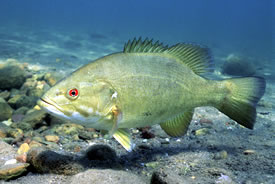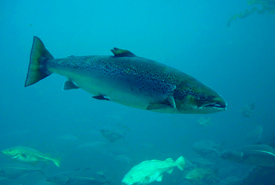Something's Fishy: Colder waters

Bull Trout in Cultus Creek, Darkwoods, British Columbia (Photo by Bruce Kirkby)
Snow and colder temperatures are synonymous when it comes to talking about Canada. Whether they’re a fan of the fluffy white stuff or they’d rather snuggle up with a hot cup of cocoa, Canadians across the Great White North have adapted to frozen terrain.
And so have freshwater fish.
Unlike humans and other warm-body species, cold-blooded fish can’t don thicker layers of fur or a sweater to cope when chilly temperatures arise. Instead, they’ve adapted by reverting to a life in slow-motion.

Smallmouth bass (Photo by USFWS, Eric Engbritson)
Since they lack a thermal system like land-based mammals, some freshwater fish swim very slowly to conserve energy. This state of lethargy is similar to hibernation, as it helps the fish to limit the amount of energy it exerts, minimizing the need for food that may be difficult to find. Some species also produce antifreeze proteins to help keep their bodies moving in the chilly water.
Food is sparse in winter, compared to the summer, as fish are unable to catch prey from the surface. Therefore, they must rely on food trapped under the water, such as smaller fish, leeches, insects, crustaceans or plankton, depending on the size of the species.
As lakes and rivers begin to freeze over, freshwater fish seek out warmer waters below the ice. Species such as largemouth and small bass will search for warm pockets in which to live out the winter, usually near the bottom of the waterbody.

Atlantic salmon (Photo by Hans-Petter Fjeld/Wikimedia Commons)
Rushing waters are usually a freshwater fish’s dream, but in winter some species will opt for stiller waters. Deep pools or large rocks or logs provide shelter from the current — there is no current to fight, which means no energy is wasted.
Just like there are two types of Canadians in winter — ones who prefer admiring the season from inside and ones who love playing in the snow — some fish don’t hide away when water temperatures drop.
Freshwater species such as trout and salmon actually seek out colder waters and remain active throughout winter. While species such as bass remain near the bottom of the water, salmon and trout swim near the surface. The warm water where bass reside is around 4 C, and sinks to the bottom of a watershed. Floating above this warm water is the colder water where the salmon and trout are found during the colder months. Since warm water is heavier than cold water, the latter rises above and is closer to the surface.
Life continues, under the ice, for freshwater fish during winter, just as it does for species on land. Whether or not you’re a winter warrior or a warm-weather wisher, brace yourself — winter is coming.
Something’s Fishy is a monthly series written by NCC’s Editorial Coordinator, Raechel Bonomo, highlighting a species or group of fishes that inhabitant Canadian waters.


